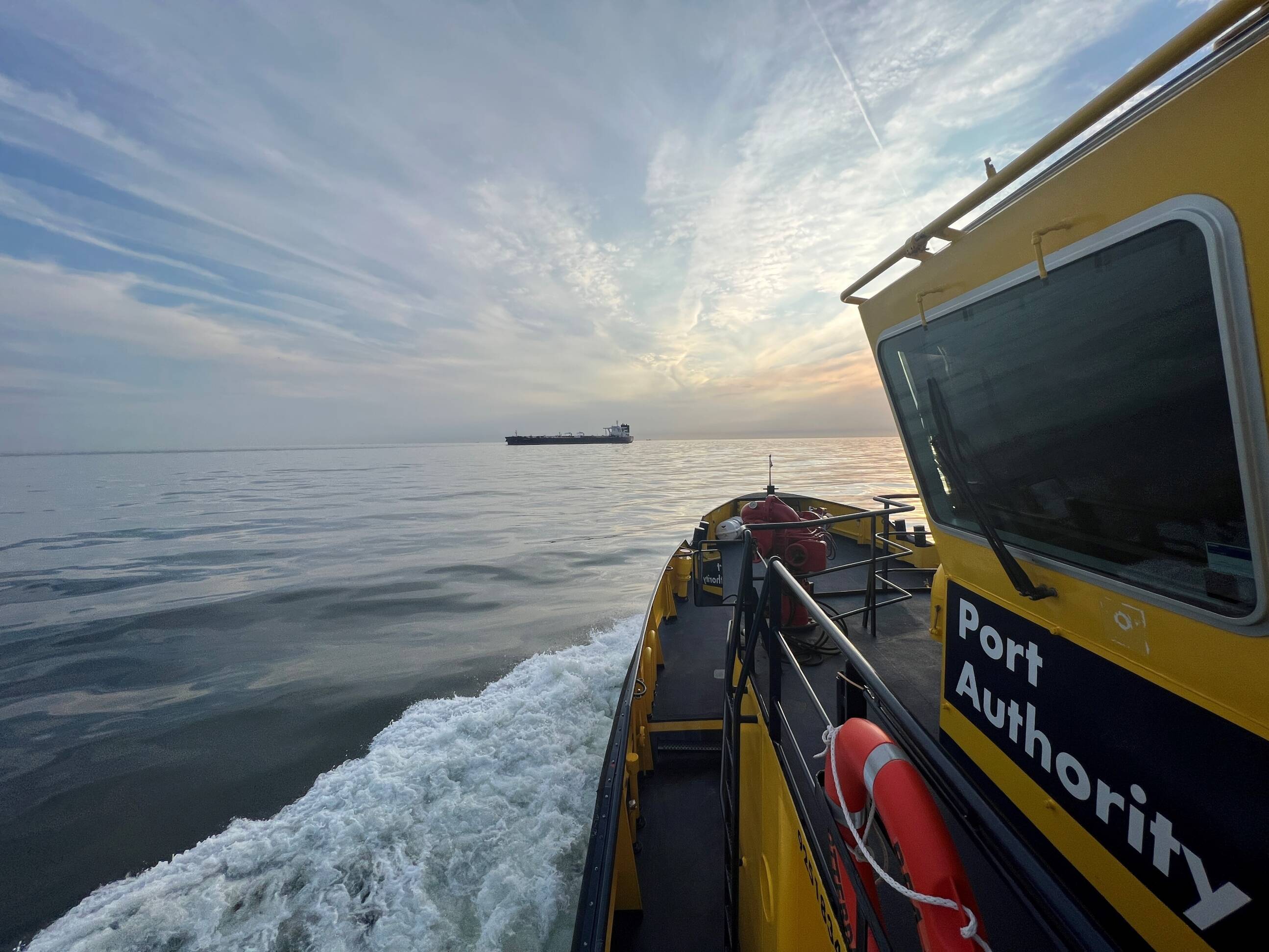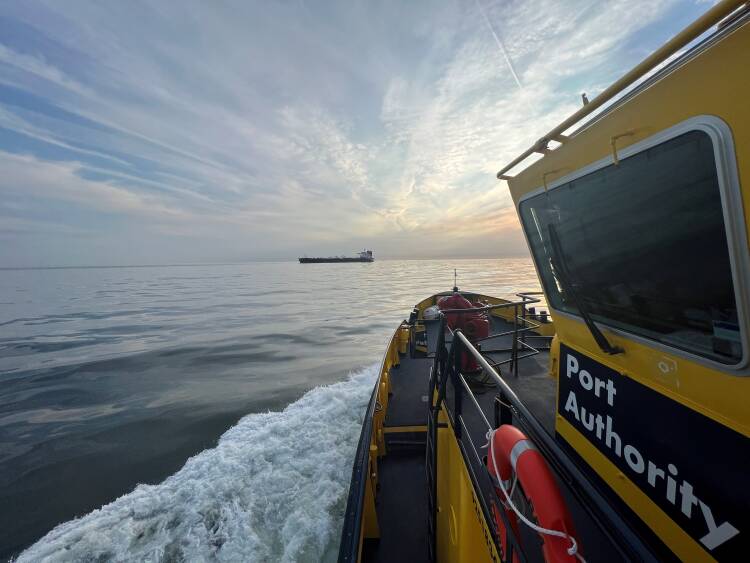
Watch the broadcast below
Zembla broadcast
On Sunday 13 October, Zembla reported on the so-called Russian shadow fleet in a broadcast on NPO 2. The role of the Harbour Master’s Division of the Port of Rotterdam Authority was also highlighted in the programme. Harbour Master René de Vries explained during the broadcast how the Harbour Master’s Division grants vessels access to the port of Rotterdam. The programme also covered collaboration with other authorities.
Scroll down
HEADLINES
Shadow fleet in Rotterdam
Incidents have also been reported in the Rotterdam approach area involving ships that are part of the shadow fleet and have switched off their AIS during their trip. The 14thand 15thsanctions packages placed 79 shadow ships on the sanctions list, prohibiting them from accessing ports within the European Union. The Coastguard provides information about these vessels to DHMR. Additionally, DHMR assesses whether vessels have a “Last Port of Call” in Russia, the type of vessel, and whether they are flying the Russian flag.
Based on this information, the Coastguard is notified and requested to further assess the vessel and its cargo for compliance with sanctions. The Coastguard evaluates such vessels in collaboration with Customs. In this way, close collaboration and information sharing help to keep the port of Rotterdam safe and compliant with sanctions.
DHMR collaborates intensively with other parties. A biweekly meeting is held under the chairmanship of the Ministry of Infrastructure and Water Management, together with the Port of Rotterdam Authority, Rijkswaterstaat, Customs, the Coastguard, and the Human Environment and Transport Inspectorate (ILT). In these meetings, cases and bottlenecks are discussed collectively.
Collaboration with other parties
DHMR plays a coordinating role, overseeing various stakeholders and nautical service providers involved in the safe mooring of vessels at the designated berths in the port. DHMR is informed by the Coastguard and Customs about vessels identified as sanctioned ships. Vessels flying the Russian flag are always considered sanctioned ships. Vessels under non-Russian flags with a previous port of call in Russia are classified as sanctioned ships if they are transporting Russian cargo that does not fall under exemption provisions (such as LNG).
If it is unclear whether the ship is carrying sanctioned cargo, DHMR will keep the vessel outside the port of Rotterdam until Customs determines whether or not the cargo is subject to sanction measures. Based on this advice, the vessel may still be granted permission to enter the port. In such cases, the Harbour Master adheres to the sanctions measures and the assessments of Customs and the Coastguard.
How the admission policy works
The port of Rotterdam is one of the busiest ports in Europe. Every year, 28,000 seagoing vessels call at the port, which equates to approximately 80 ships per day. The Harbour Master’s Division of the Port of Rotterdam Authority (DHMR) is responsible for the safe and efficient handling of maritime traffic within the port. The traffic guidance for ships begins in the so-called approach area in the North Sea, which starts 60 kilometres west of the port entrance. Seagoing vessels calling at Rotterdam must provide extensive information to DHMR before they are permitted to enter the port. This includes information such as the vessel’s length, draught, type of cargo, expected arrival and departure times, and the last ten ports of call.
This image is for illustrative purposes only and does not necessarily reflect the content of the article.
The shadow fleet consists of outdated, often uninsured vessels that transport crude Russian oil and oil products between Russian ports and countries like China and India, where sanctions on Russian oil do not apply. Shadow ships often change their flag, name, and ownership. They also conceal their location and speed by disabling the AIS (Automatic Identification System), making them difficult to track and increasing the risk of unsafe situations. In addition to loading and discharging crude oil and oil products at ports, these vessels also carry out ship-to-ship transfer operations, transferring oil between vessels on the open sea. These high-risk operations must adhere to strict guidelines, as even a minor mishap could lead to an oil spill, resulting in an environmental disaster.
Following sanctions against Russia, it has been prohibited since April 2022 for ships flying the Russian flag to access ports within the European Union. This ban also applies to the port of Rotterdam. Russia is attempting to circumvent these rules through a so-called shadow fleet. Why does this fleet pose such a safety risk and how does the (State) Harbour Master ensure these vessels cannot berth at the port of Rotterdam?
How does the Harbour Master of Rotterdam address Russian shadow ships?
The images in this article are for illustrative purposes only and do not necessarily reflect the content of the article.
Watch the broadcast below
On Sunday 13 October, Zembla reported on the so-called Russian shadow fleet in a broadcast on NPO 2. The role of the Harbour Master’s Division of the Port of Rotterdam Authority was also highlighted in the programme. Harbour Master René de Vries explained during the broadcast how the Harbour Master’s Division grants vessels access to the port of Rotterdam. The programme also covered collaboration with other authorities.
Zembla broadcast

Besides delays in infrastructure construction, sustainability plans increasingly face challenges in terms of permits, nitrogen levels, rising costs, slow market development and lack of space and staff shortages. The Port of Rotterdam Authority is therefore calling for a clear, green industrial policy from central government and Europe to ensure the transition succeeds.
Incidents have also been reported in the Rotterdam approach area involving ships that are part of the shadow fleet and have switched off their AIS during their trip. The 14thand 15thsanctions packages placed 79 shadow ships on the sanctions list, prohibiting them from accessing ports within the European Union. The Coastguard provides information about these vessels to DHMR. Additionally, DHMR assesses whether vessels have a “Last Port of Call” in Russia, the type of vessel, and whether they are flying the Russian flag.
Based on this information, the Coastguard is notified and requested to further assess the vessel and its cargo for compliance with sanctions. The Coastguard evaluates such vessels in collaboration with Customs. In this way, close collaboration and information sharing help to keep the port of Rotterdam safe and compliant with sanctions.
Shadow fleet in Rotterdam
DHMR collaborates intensively with other parties. A biweekly meeting is held under the chairmanship of the Ministry of Infrastructure and Water Management, together with the Port of Rotterdam Authority, Rijkswaterstaat, Customs, the Coastguard, and the Human Environment and Transport Inspectorate (ILT). In these meetings, cases and bottlenecks are discussed collectively.
Risks to greening
DHMR plays a coordinating role, overseeing various stakeholders and nautical service providers involved in the safe mooring of vessels at the designated berths in the port. DHMR is informed by the Coastguard and Customs about vessels identified as sanctioned ships. Vessels flying the Russian flag are always considered sanctioned ships. Vessels under non-Russian flags with a previous port of call in Russia are classified as sanctioned ships if they are transporting Russian cargo that does not fall under exemption provisions (such as LNG).
If it is unclear whether the ship is carrying sanctioned cargo, DHMR will keep the vessel outside the port of Rotterdam until Customs determines whether or not the cargo is subject to sanction measures. Based on this advice, the vessel may still be granted permission to enter the port. In such cases, the Harbour Master adheres to the sanctions measures and the assessments of Customs and the Coastguard.
Collaboration with other parties
The port of Rotterdam is one of the busiest ports in Europe. Every year, 28,000 seagoing vessels call at the port, which equates to approximately 80 ships per day. The Harbour Master’s Division of the Port of Rotterdam Authority (DHMR) is responsible for the safe and efficient handling of maritime traffic within the port. The traffic guidance for ships begins in the so-called approach area in the North Sea, which starts 60 kilometres west of the port entrance. Seagoing vessels calling at Rotterdam must provide extensive information to DHMR before they are permitted to enter the port. This includes information such as the vessel’s length, draught, type of cargo, expected arrival and departure times, and the last ten ports of call.
How the admission policy works
The shadow fleet consists of outdated, often uninsured vessels that transport crude Russian oil and oil products between Russian ports and countries like China and India, where sanctions on Russian oil do not apply. Shadow ships often change their flag, name, and ownership. They also conceal their location and speed by disabling the AIS (Automatic Identification System), making them difficult to track and increasing the risk of unsafe situations. In addition to loading and discharging crude oil and oil products at ports, these vessels also carry out ship-to-ship transfer operations, transferring oil between vessels on the open sea. These high-risk operations must adhere to strict guidelines, as even a minor mishap could lead to an oil spill, resulting in an environmental disaster.
How does the Harbour Master of Rotterdam address Russian shadow ships?
Following sanctions against Russia, it has been prohibited since April 2022 for ships flying the Russian flag to access ports within the European Union. This ban also applies to the port of Rotterdam. Russia is attempting to circumvent these rules through a so-called shadow fleet. Why does this fleet pose such a safety risk and how does the (State) Harbour Master ensure these vessels cannot berth at the port of Rotterdam?
HEADLINES